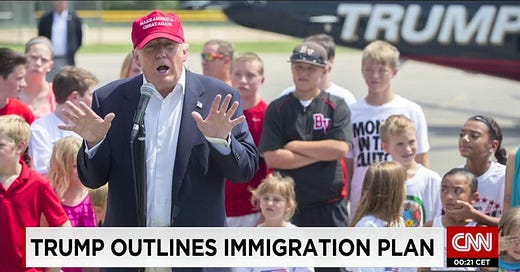A version of this essay was published by deccanherald.com at https://www.deccanherald.com//opinion/border-closing-the-trumpian-shift-is-here-3279841
I am starting, by invitation, a new monthly column ‘Abroad at Home’ in print at the Deccan Herald newspaper.
The podcast above is AI-generated by Google NotebookLM.
Illegal immigration is now a core concern in many western countries, and was one of the factors that propelled Donald Trump to his thumping victory in the US Presidential election. True to form, Trump announced on Monday that he would appoint Tom Homan, a strong proponent of leak-proof borders, as his ‘border czar’.
Then there’s Stephen Miller, designated deputy Chief of Staff, a known hawk about both legal and illegal immigration. The two of them defended things like family separation, including in a Congressional hearing.
Trump has vowed to deport illegal aliens on an unprecedented scale, hire thousands of border agents, and even invoke the Alien Enemies Act of 1798 against drug cartels and criminal gangs to expel them without a court hearing.
Especially after recurring episodes of rioting, arson and loot in European capitals, and pro-Palestine protests in the recent past, this may be popular among the US public considering that some 11 million illegal migrants simply walked into the US under Biden.
There is another group, though: legal immigrants who have been in limbo for years, sometimes decades, in the bowels of the immigration system. As is well known, a lot of them are Indian-origin people, especially engineers, who went to the US on H1-B work visas.
In earlier times (before the 1999 Y2k scare, that is), there were fewer Indians in the US: most of them, like me, had come on student visas, and opted to stay on to work. Within a year or two, we went through a process called Labor Certification which in effect said that we were not displacing a US citizen of equivalent qualifications, and then we got a Green Card.
The catch is that there is a limit to the number of Green Cards (675,000 a year) of which 140,000 are for the employment-related category. In 1990, with a new Immigration Act, a per-country cap of 7% was imposed, which means that just 9,800 work-related Green Cards are available per year per country, including India.
There are also sub-categories, such as ‘persons of extraordinary merit’, those with advanced degrees and abilities, ‘skilled workers’, ‘professional workers’, and religious workers, so it does get quite complicated.
The net result is that post-1990 Indian immigrants now face very long waits, some say as much as 100 years. Meanwhile, applicants from other countries with shorter waiting lists are able to become permanent residents much quicker.
This leads to, I am sorry to say, a sort of indentured labor for Indians on H-1B visas. In a modern twist on the old system where the British took hundreds of thousands of Indians to places like the West Indies and East Africa, today they are in trisanku mode where they have no clarity when, and if, they will get permanent residency. The conditions on their visas sometimes prevent them from changing employers so that they are, in effect, stuck.
A friend’s son in Silicon Valley exemplifies this problem. He has been awaiting his Green Card for thirteen years, and he is now wondering if he will have to go for Plan B: which is to have his 10 year-old US-born, and thus citizen, son sponsor him when he becomes an adult!
Alas, that avenue may close, because there is speculation that the Trump administration wants to do away with the ‘birthright-citizenship’ clause, because, among other things, it is leading to ‘birth-tourism’ with heavily pregnant foreigners coming to the US just to deliver their babies.
The 14th Amendment, 1868, makes any child born in the US eligible for citizenship. There is the possibility that a rider will be attached to this: that only the children of citizens, or of Green Card holders, will be thus eligible.
On the other hand, Trump might make a distinction between two types of immigrants – let us call them ‘desirable' and ‘undesirable’ – and make exceptions for the former. They are net contributors to the US economy (an Economist study suggests that certain nationalities of immigrants are such); others are a net burden on the State.
Indian-Americans, who are the best-educated and highest-earning of all ethnic communities in the US, could fairly claim to be in the former category. Indians are also founders of the largest number of unicorns in the US.
On the other hand, if life becomes difficult for them, they may start a ‘reverse brain-drain’ back to India. That would not be, all things considered, such a bad thing either. India should make them welcome, as Taiwan did with astonishing results, such as pre-eminence in chipmaking.
775 words, 12 Nov 2024












Share this post